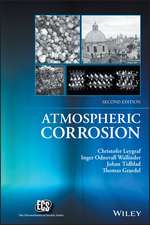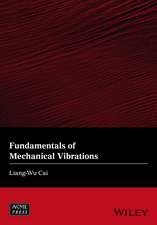Hydrogen and Helium Recycling at Plasma Facing Materials: NATO Science Series II: Mathematics, Physics and Chemistry, cartea 54
Editat de Ahmed Hassaneinen Limba Engleză Hardback – 31 mar 2002
| Toate formatele și edițiile | Preț | Express |
|---|---|---|
| Paperback (1) | 638.11 lei 6-8 săpt. | |
| SPRINGER NETHERLANDS – 31 mar 2002 | 638.11 lei 6-8 săpt. | |
| Hardback (1) | 643.16 lei 6-8 săpt. | |
| SPRINGER NETHERLANDS – 31 mar 2002 | 643.16 lei 6-8 săpt. |
Din seria NATO Science Series II: Mathematics, Physics and Chemistry
- 18%
 Preț: 1272.32 lei
Preț: 1272.32 lei - 15%
 Preț: 644.30 lei
Preț: 644.30 lei - 18%
 Preț: 1848.33 lei
Preț: 1848.33 lei - 18%
 Preț: 1235.76 lei
Preț: 1235.76 lei - 15%
 Preț: 649.87 lei
Preț: 649.87 lei - 18%
 Preț: 957.75 lei
Preț: 957.75 lei - 15%
 Preț: 656.58 lei
Preț: 656.58 lei - 18%
 Preț: 1235.43 lei
Preț: 1235.43 lei - 18%
 Preț: 960.13 lei
Preț: 960.13 lei - 18%
 Preț: 1225.79 lei
Preț: 1225.79 lei - 15%
 Preț: 666.41 lei
Preț: 666.41 lei - 18%
 Preț: 1835.07 lei
Preț: 1835.07 lei - 15%
 Preț: 640.71 lei
Preț: 640.71 lei - 18%
 Preț: 954.45 lei
Preț: 954.45 lei - 18%
 Preț: 1227.36 lei
Preț: 1227.36 lei - 15%
 Preț: 646.11 lei
Preț: 646.11 lei - 18%
 Preț: 948.61 lei
Preț: 948.61 lei -
 Preț: 400.10 lei
Preț: 400.10 lei - 18%
 Preț: 959.82 lei
Preț: 959.82 lei - 18%
 Preț: 944.19 lei
Preț: 944.19 lei - 18%
 Preț: 1838.38 lei
Preț: 1838.38 lei - 18%
 Preț: 1222.49 lei
Preț: 1222.49 lei - 18%
 Preț: 939.94 lei
Preț: 939.94 lei - 18%
 Preț: 950.66 lei
Preț: 950.66 lei - 18%
 Preț: 957.44 lei
Preț: 957.44 lei - 15%
 Preț: 656.74 lei
Preț: 656.74 lei
Preț: 643.16 lei
Preț vechi: 756.65 lei
-15% Nou
Puncte Express: 965
Preț estimativ în valută:
123.07€ • 131.60$ • 102.61£
123.07€ • 131.60$ • 102.61£
Carte tipărită la comandă
Livrare economică 17 aprilie-01 mai
Preluare comenzi: 021 569.72.76
Specificații
ISBN-13: 9781402005114
ISBN-10: 1402005113
Pagini: 248
Ilustrații: IX, 235 p. 40 illus.
Dimensiuni: 170 x 244 x 19 mm
Greutate: 0.49 kg
Ediția:2002
Editura: SPRINGER NETHERLANDS
Colecția Springer
Seria NATO Science Series II: Mathematics, Physics and Chemistry
Locul publicării:Dordrecht, Netherlands
ISBN-10: 1402005113
Pagini: 248
Ilustrații: IX, 235 p. 40 illus.
Dimensiuni: 170 x 244 x 19 mm
Greutate: 0.49 kg
Ediția:2002
Editura: SPRINGER NETHERLANDS
Colecția Springer
Seria NATO Science Series II: Mathematics, Physics and Chemistry
Locul publicării:Dordrecht, Netherlands
Public țintă
ResearchCuprins
Hydrogen Recycling Studies in Tokamaks and Other Facilities.- 1. Hydrogen Isotopes Retention in Fusion Reactor Plasma-facing Materials: An Abbreviated Review.- 2. Trapping Effect in Hydrogen Retention in Metals.- 3. Recent Progress in Tritium Codeposition Modeling.- 4. The Effect of Deuterium Ion Bombardment on the Optical Properties of Beryllium Mirrors.- 5. Hot Liner Divertor Concept Analysis of Dust Formation and Locations.- Hydrogen Sputtering, Retention, Codeposition in Graphite.- 6. Hydrogen Isotope Retention Analysis for Tokamak Plasma-facing Materials.- 7. Surface Microrelief Influence on Hydrogen Interaction with Materials.- Hydrogen Recycling in Liquid Metals.- 8. Deuterium Treatment Effects on Lithium and TiN-Lithium Sputtering in Solid and Liquid Phase.- 9. Helium Entrapment in Liquid Metal Plasma-facing Surfaces in Tokamak Fusion Reactors.- Fundamental Permeation Studies I.- 10. A Model for the Steady State Plasma- and Gas-driven Hydrogen Isotope Permeation through Multi-layer Metal.- 11. Effect of Hydrogen Sorption on Surface Morphology of Pyrolytic Graphite.- Fundamental Permeation Studies II.- 12. General Model of Hydrogen Transport through Solid Membranes.- 13. Influence of Hydrogen and Helium on Radiation Damage of Structural Materials.- Hydrogen Recycling in Tungsten, Niobium, and Nickel.- 14. Deuterium Retention in Tungsten and Tungsten Carbides Irradiated with D Ions.- 15. An Interpretation of the Retention of Low Energy Deuterium Ions in Tungsten.- General Hydrogen and Helium Issues and Other Metals.- 16. Hydrogen Interaction with TiN Films.- 17. Bimetallic Diffusion Membranes: Possible Use for Active Hydrogen Recycling Control.- 18. Surface Evolution of Nickel under He and H Ion Irradiation by means of Kelvin Probe.- Measurements and Control of Hydrogen Recycling I.- 19. Development of an Innovative Carbon-based Ceramic Material; Application in High Temperature, Neutron and Hydrogen Environment.- 20. Nonmonotone Temperature Dependence of Plasma Driven Permeation through Nb Membrane.- Measurements and Control of Hydrogen Recycling II.- 21. Usage of Hydrogen-saturated Getter for Sputtering Protection of Construction Elements in Vacuum-plasma Installations.- 22. Laser Induced Breakdown Spectroscopy Technique for In-situ Dust Detecting in a Next-step Tokamak.- Authors.





